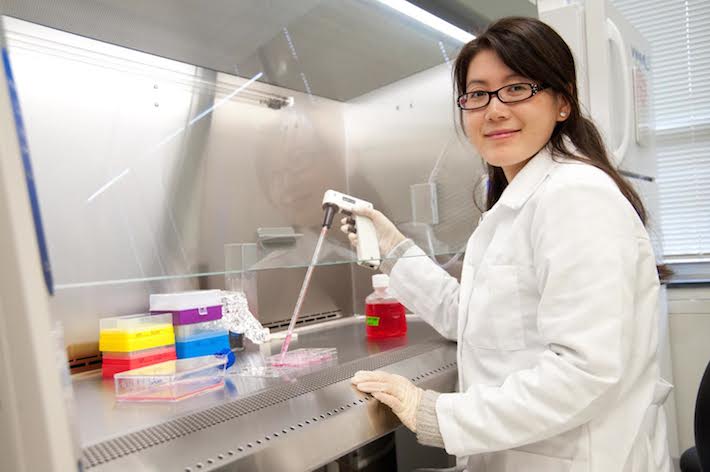Medical researchers are steps closer to creating human organs using 3D printers, but they have significant barriers to cross before science fiction becomes a reality.
A George Washington University researcher is addressing those obstacles with a project that could pave the way for complex tissue regeneration.
Lijie Grace Zhang, an assistant professor in the School of Engineering and Applied Science, has received a prestigious 2014 Director’s New Innovator Award from the National Institutes of Health. The award totals $2,287,500. Her five-year project, titled “A Novel 3D Bioprinted Smart Vascularized Nano Tissue,” aims to find a solution for treating large tissue defects in patients.
The New Innovator Award is designed “to support unusually creative new investigators with highly innovative research ideas at an early stage of their career,” according to the NIH.
With the 3D bioprinting technique, scientists build tissue and organs, layer by layer, using a printer. The process enables them to create custom-designed tissue organ substitutes. While this technology has gained momentum in recent years, researchers still are struggling to regenerate complex tissues, such as vascularized bone, cartilage and muscle.
Critical-sized bone defects that are caused by traumatic injury or diseases such as cancer are notoriously difficult to regenerate. Large and complex portions of tissue need to have an adequate vascular network to survive and thrive post-defect. Bioprinting vascular networks, which mimic the body’s circulatory system, is the key to 3D printed organs, Dr. Zhang said.
This project will combine Dr. Zhang’s experience in nanobiomaterials, tissue engineering and drug delivery with advanced 3D bioprinting techniques to develop a vascularized bone tissue construct using “smart” materials.
Dr. Zhang’s bioprinting system will have two features distinctive from those of other labs. First, Dr. Zhang and her research team will use a class of highly innovative nanomaterials.
“Since human tissue in its basic form is full of nanoscale features, these nanomaterials will play a key role in modulating the repair and regeneration of tissues,” Dr. Zhang said.
Second, Dr. Zhang and her team will create the microvascular network using “smart” materials, a special type of shape memory material that can change over time.
“With this award, I want to create a product that is really useful for human health,” she said.
The New Innovator Award supports investigators who are within 10 years of their terminal degree or clinical residency, who have not yet received a research project grant (R01) or equivalent NIH grant, to conduct innovative research.
“Professor Zhang’s research has the potential to impact not only clinical bone treatment and tissue and organ regeneration, but also basic physical and life science research,” said SEAS Dean David Dolling. “Researchers who are able to develop the sorts of insights that spawn truly pioneering investigations like Professor Zhang’s are rare, and the NIH New Innovator awards are rightly reserved for them.”
The award comes as Dr. Zhang prepares to move into a newly constructed Science and Engineering Hall, which opens in 2015 and will allow Dr. Zhang to expand her research portfolio.
“I am thrilled that Dr. Zhang has been recognized with a distinction that she so richly deserves,” said Michael Plesniak, chair of the Department of Mechanical and Aerospace Engineering. “Her innovative research will make contributions to the field of tissue engineering and will have a positive impact on many lives."




